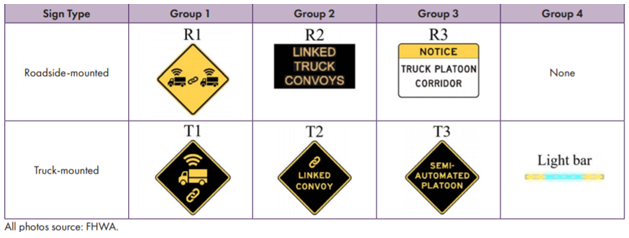Study Presented Drivers with Potential Indicators in Simulated Scenarios to Assess Safety Perceptions of Truck Platoons and Predictability in Lane Changing.
Nationwide, United States
Effective Indicators of Partially Automated Truck Platooning
Summary Information
Partially automated truck platoons typically consist of two to four trucks operating under cooperative adaptive cruise control (CACC) to achieve close-distance following over long trips to yield fuel and cost savings. Road interactions between light vehicles and heavy trucks have important implications for road safety as well as public acceptance of heavy truck automation. Given that most drivers of light vehicles will be unfamiliar with platooning technology during its early deployment, communicating information about truck platoon operations to surrounding road users may improve drivers’ comfort and perceived safety near platoons, facilitate earlier and safer navigational planning, and discourage cut-ins between platooning trucks. Researchers studied several methods of communicating truck platooning information in an effort to identify terms and language that appropriately reflect platoon operations and characteristics. After identifying recognizable terms and essential platoon characteristics, the research team developed a set of four novel signs and indicators designed to support road user comprehension, comfort, and safety near truck platoons.
Two experiments were conducted to develop potential signs and indicators and evaluate their effectiveness in supporting road user comprehension and perceived safety of a simulated partially automated two-truck platoon.
- Experiment 1 surveyed 50 participants to determine how drivers describe and respond to single and grouped conventionally driven trucks.
- Experiment 2 presented 48 new participants with static simulated scenarios of a two-truck platoon with and without novel signs and indicators (see Figure 1) developed from the findings of experiment 1.

Figure 1: Illustrations of novel signs and indicators assessed in simulated scenarios
- Use newly designed signs or indicators to effectively influence drivers’ perceptions of trucks’ operations and the relationship between them. Over 60 percent of participants presented with the novel signs and indicators expected the rear truck in a group to follow the lead truck into the left lane, compared to 20 percent in the scenario without these signs or indicators.
- Expect drivers’ learned experiences with conventionally driven trucks to affect perceptions when interacting with truck platooning technology. The survey revealed that drivers’ experiences with conventionally driven trucks caused them to expect trucks to operate independent of one another and even competitively. This could lead drivers to perceive trucks following other vehicles at short distances as potential aggressors.
- Widely used terms in the transportation industry may not be readily understood by the general public. Although commonly used in the advanced transportation industry, the term “platoon” was not readily understood by participants. When asked to select from among a list of predefined terms, 72 percent of the participants preferred “convoy” to label a group of partially automated trucks.
